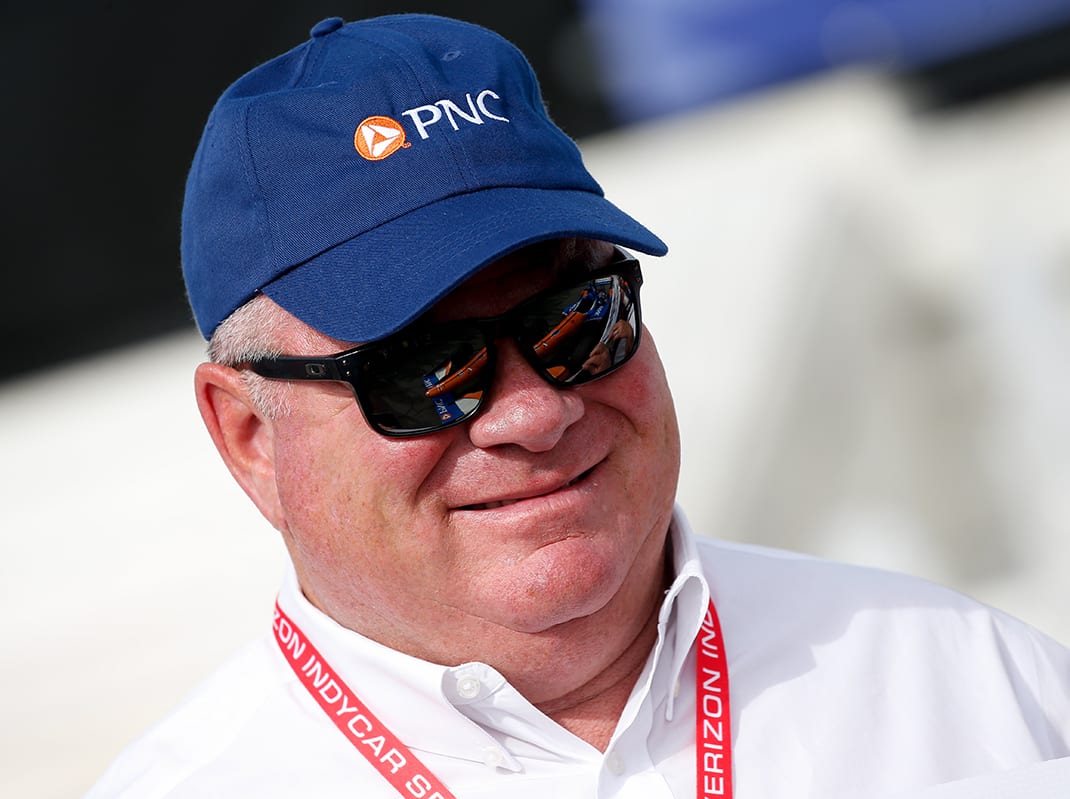Ganassi’s father, Floyd, was a popular Pittsburgh real estate developer and businessman. He took 13-year-old Chip to the Indianapolis 500 in 1971.
“It was also the year when the pace car ran into the photo stand at the end of the pits,” Ganassi remembered. “That was a disaster. I remember Al Unser won in the Johnny Lightning Special. That was my first year there. I was only there twice before I actually drove there.
“I was there in 1971 as a spectator and 1981 as a spectator, but I was driving in Super Vees at the time,” Ganassi noted. “Then, I came back in 1982 as a driver.”
Ganassi skipped his commencement ceremony at Duquesne University in 1982 — and for good reason.
“I was busy qualifying at Indy,” he recalled.
Ganassi was driving the No. 12 First Commercial Corp. Wildcat/Cosworth for car owner Jack Rhoades. He started 12th and finished 15th.
From 1982 to ’86, Ganassi competed in 32 Indy car races, including five Indianapolis 500s. He had a pair of third-place finishes in 1983 while driving for Pat Patrick.
The following year, Ganassi drove the Old Milwaukee Special to a second-place finish behind Danny Sullivan in the Budweiser Cleveland Grand Prix for the best finish of his career.
Later that year, Ganassi was involved in a horrific crash at Michigan Int’l Speedway that saw his car flip wildly down the backstretch.
Ganassi endured a lengthy recovery but returned to run three races in 1985.
He finished 21st in the 1986 Indianapolis 500, which was his final race as a driver.
Ganassi then turned his interest to the business of racing with hopes of becoming a team owner. He purchased part of Patrick Racing in the late 1980s, and Ganassi and Patrick were together in victory lane when Emerson Fittipaldi won the 1989 Indianapolis 500.
By 1990, Chip Ganassi Racing was formed and showed up at the Indianapolis 500 with an all-white Target-sponsored car driven by Eddie Cheever.
“Those were heady times,” Ganassi recalled. “I remember Eddie coming over from Formula One. He was as American as could be when you talked to him, but he had never been in a McDonald’s before. When I first met him, he didn’t know what to order there. Eddie was quite a guy, he got us started, and I’ll forever remember that.
“The thing I remember about that year at Indy, in those days they gave a pace car to the drivers and Eddie came in one morning and said, ‘Some guy bumped me from behind, so I ran him off the road.’ I said, ‘Who was it?’ He said, ‘Some guy named Carroll.’
“I said, ‘Carroll, Carroll — Carroll Shelby!’ He said, ‘Yeah, that’s it.’
“I said, ‘Jesus, Eddie, don’t you know who Carroll Shelby is?’ He said, ‘I’ve heard of him. Who is he?’
“Eddie was a unique guy and a lot of fun to be around and a lot of fun to be around even to this day.”
In 1993, Arie Luyendyk won the Indy 500 pole in Ganassi’s car. Luyendyk finished second to Fittipaldi in the 500 and notched five top-five finishes in 16 races that season. But Ganassi’s team still hadn’t won a race.
Before the 1994 season, Ganassi signed Michael Andretti as his driver. Ganassi said if his team doesn’t win a race, maybe he shouldn’t be a team owner.
“It’s true,” Ganassi admitted. “We thought we had all the pieces, but it was hard in those days. You had Carl Haas selling Lolas and Roger Penske selling his year-old cars. Then, March came along and they had their favorites. I had to figure out something to give us an advantage.
“Running into Adrian Reynard and Rick Gorne did it for me,” Ganassi said. “That was my launch. Running into them, putting Reynard (chassis) together with Honda and Firestone, that was a pretty potent package in those days.”
Andretti won the first race of the season at Surfer’s Paradise in Australia. A second victory came in Toronto.
Jimmy Vasser and Bryan Herta joined the team in 1995. In 1996, a young Italian named Alex Zanardi came on board and a dynasty was taking shape.
“By the time 1996 rolled around, we went into the final race of the championship at Laguna Seca with Jimmy Vasser leading the points, but you had Al Unser Jr. and Michael Andretti within striking distance of the championship if Jimmy had an issue,” Ganassi said. “Those were some pretty heady days.
“You had three different chassis, with three different engines and two different tire makers all vying for the championship at the final race of the season. That was the famous Zanardi race when he made the pass and we won the championship, all in one lap.
“The rest was history after that.”
Click below to continue reading.
